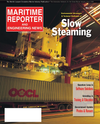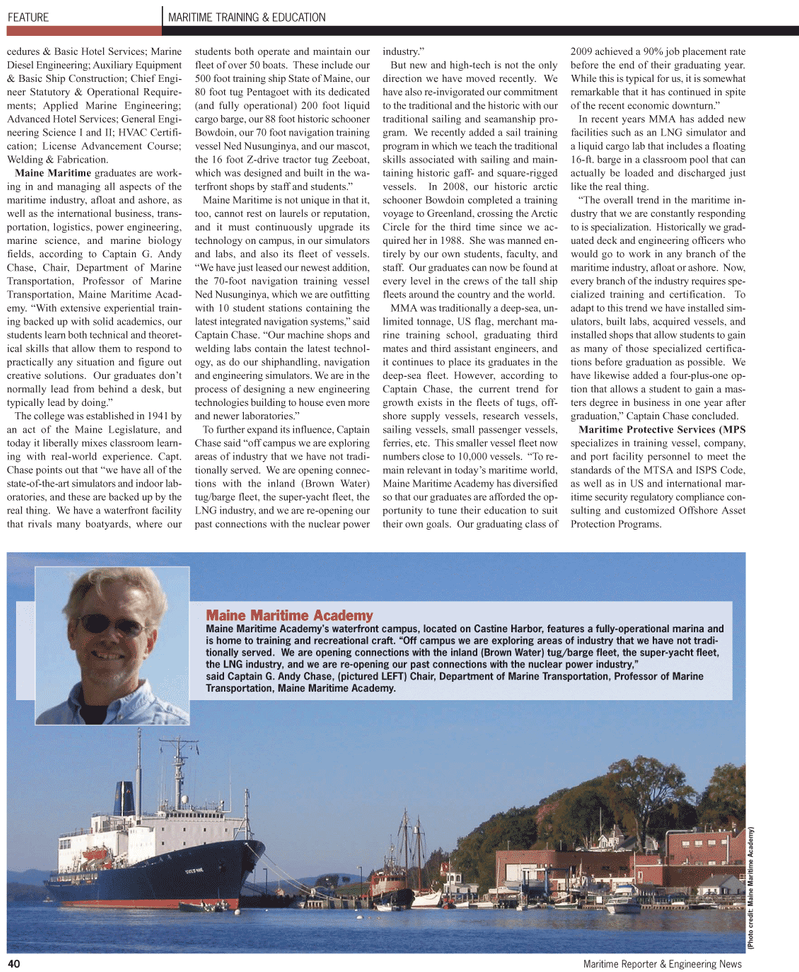
Page 40: of Maritime Reporter Magazine (May 2, 2010)
Read this page in Pdf, Flash or Html5 edition of May 2, 2010 Maritime Reporter Magazine
40 Maritime Reporter & Engineering News
Maine Maritime Academy
Maine Maritime Academy's waterfront campus, located on Castine Harbor, features a fully-operational marina and is home to training and recreational craft. “Off campus we are exploring areas of industry that we have not tradi- tionally served. We are opening connections with the inland (Brown Water) tug/barge fleet, the super-yacht fleet, the LNG industry, and we are re-opening our past connections with the nuclear power industry,” said Captain G. Andy Chase, (pictured LEFT) Chair, Department of Marine Transportation, Professor of Marine
Transportation, Maine Maritime Academy.
FEATURE MARITIME TRAINING & EDUCATION cedures & Basic Hotel Services; Marine
Diesel Engineering; Auxiliary Equipment & Basic Ship Construction; Chief Engi- neer Statutory & Operational Require- ments; Applied Marine Engineering;
Advanced Hotel Services; General Engi- neering Science I and II; HVAC Certifi- cation; License Advancement Course;
Welding & Fabrication.
Maine Maritime graduates are work- ing in and managing all aspects of the maritime industry, afloat and ashore, as well as the international business, trans- portation, logistics, power engineering, marine science, and marine biology fields, according to Captain G. Andy
Chase, Chair, Department of Marine
Transportation, Professor of Marine
Transportation, Maine Maritime Acad- emy. “With extensive experiential train- ing backed up with solid academics, our students learn both technical and theoret- ical skills that allow them to respond to practically any situation and figure out creative solutions. Our graduates don’t normally lead from behind a desk, but typically lead by doing.”
The college was established in 1941 by an act of the Maine Legislature, and today it liberally mixes classroom learn- ing with real-world experience. Capt.
Chase points out that “we have all of the state-of-the-art simulators and indoor lab- oratories, and these are backed up by the real thing. We have a waterfront facility that rivals many boatyards, where our students both operate and maintain our fleet of over 50 boats. These include our 500 foot training ship State of Maine, our 80 foot tug Pentagoet with its dedicated (and fully operational) 200 foot liquid cargo barge, our 88 foot historic schooner
Bowdoin, our 70 foot navigation training vessel Ned Nusunginya, and our mascot, the 16 foot Z-drive tractor tug Zeeboat, which was designed and built in the wa- terfront shops by staff and students.”
Maine Maritime is not unique in that it, too, cannot rest on laurels or reputation, and it must continuously upgrade its technology on campus, in our simulators and labs, and also its fleet of vessels. “We have just leased our newest addition, the 70-foot navigation training vessel
Ned Nusunginya, which we are outfitting with 10 student stations containing the latest integrated navigation systems,” said
Captain Chase. “Our machine shops and welding labs contain the latest technol- ogy, as do our shiphandling, navigation and engineering simulators. We are in the process of designing a new engineering technologies building to house even more and newer laboratories.”
To further expand its influence, Captain
Chase said “off campus we are exploring areas of industry that we have not tradi- tionally served. We are opening connec- tions with the inland (Brown Water) tug/barge fleet, the super-yacht fleet, the
LNG industry, and we are re-opening our past connections with the nuclear power industry.”
But new and high-tech is not the only direction we have moved recently. We have also re-invigorated our commitment to the traditional and the historic with our traditional sailing and seamanship pro- gram. We recently added a sail training program in which we teach the traditional skills associated with sailing and main- taining historic gaff- and square-rigged vessels. In 2008, our historic arctic schooner Bowdoin completed a training voyage to Greenland, crossing the Arctic
Circle for the third time since we ac- quired her in 1988. She was manned en- tirely by our own students, faculty, and staff. Our graduates can now be found at every level in the crews of the tall ship fleets around the country and the world.
MMA was traditionally a deep-sea, un- limited tonnage, US flag, merchant ma- rine training school, graduating third mates and third assistant engineers, and it continues to place its graduates in the deep-sea fleet. However, according to
Captain Chase, the current trend for growth exists in the fleets of tugs, off- shore supply vessels, research vessels, sailing vessels, small passenger vessels, ferries, etc. This smaller vessel fleet now numbers close to 10,000 vessels. “To re- main relevant in today’s maritime world,
Maine Maritime Academy has diversified so that our graduates are afforded the op- portunity to tune their education to suit their own goals. Our graduating class of 2009 achieved a 90% job placement rate before the end of their graduating year.
While this is typical for us, it is somewhat remarkable that it has continued in spite of the recent economic downturn.”
In recent years MMA has added new facilities such as an LNG simulator and a liquid cargo lab that includes a floating 16-ft. barge in a classroom pool that can actually be loaded and discharged just like the real thing. “The overall trend in the maritime in- dustry that we are constantly responding to is specialization. Historically we grad- uated deck and engineering officers who would go to work in any branch of the maritime industry, afloat or ashore. Now, every branch of the industry requires spe- cialized training and certification. To adapt to this trend we have installed sim- ulators, built labs, acquired vessels, and installed shops that allow students to gain as many of those specialized certifica- tions before graduation as possible. We have likewise added a four-plus-one op- tion that allows a student to gain a mas- ters degree in business in one year after graduation,” Captain Chase concluded.
Maritime Protective Services (MPS specializes in training vessel, company, and port facility personnel to meet the standards of the MTSA and ISPS Code, as well as in US and international mar- itime security regulatory compliance con- sulting and customized Offshore Asset
Protection Programs. (Photo cr edit: Maine Maritime Academy)

 39
39

 41
41
